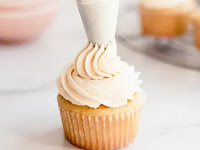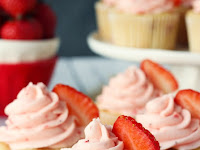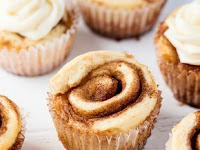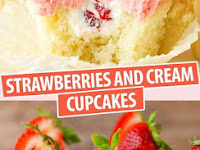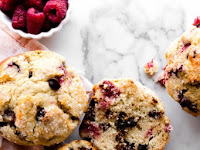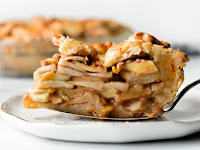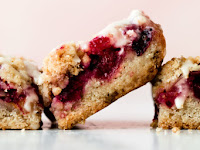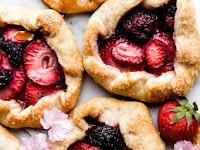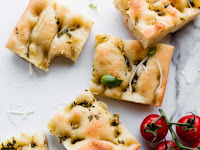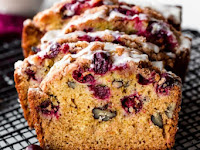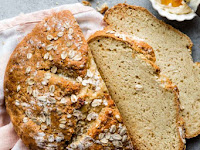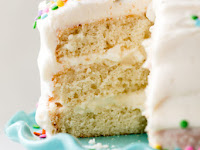
Best Chocolate Cake Recipe {& Chocolate Buttercream}
For this recipe I like to use cake strips. Once in the oven these damp strips placed around the cake pans keep the exterior from getting too hot before the interior starts to heat so the cake rises more evenly all the way across.
There are also some DIY methods if you want to make some yourself. You can skip using these then just trim the top of the cake to level.
Ingredients
1 1/2 cups (300g) granulated sugar
1/2 cup (110g) packed light-brown sugar
3/4 cup (70g) unsweetened cocoa powder (scoop and level to measure)
1 tsp baking soda
3/4 tsp salt
1 cup (235ml) boiling water*
3/4 cup (175ml) vegetable oil or canola oil
1/4 cup (56g) unsalted butter, melted
2 large eggs
3 large egg yolks
1 Tbsp vanilla extract
2 cups (256g) all-purpose flour (spoon and level to measure)
1/2 cup (116g) sour cream
1/3 cup (80ml) milk
1 recipe Chocolate Buttercream Frosting
Instructions
Preheat oven to 350 degrees. Butter two 9-inch round cake pans then line bottom of each with a round of parchment paper. Butter parchment paper. If you'd like more level cakes wrap cake pans with baking strips (which have been soaked and fully saturated with water, see notes below recipe), or you can cut top to level after baking.
In a large, heat proof mixing bowl, whisk together granulated sugar brown sugar, cocoa powder, baking soda and salt. Carefully pour boiling water in to cocoa mixture and immediately whisk to blend well. Allow to cool 5 minutes.
Using an electric hand mixer set on low speed blend in vegetable oil and melted butter until combined. Add eggs, egg yolks and vanilla extract and blend just to combined. Then add flour and blend until combined, and finish by blending in milk and sour cream just until combined.
Divide mixture evenly among 2 prepared pans. Bake in preheated oven until toothpick inserted into center of cake comes out clean or with a few moist crumbs, about 29 - 34 minutes. Allow to cool in pan 5 minutes, run butter knife around edge of cake and invert onto a wire rack and allow to cool completely.
Trim cakes level if needed. Add frosting to top of one round then top with second cake and frost top and sides of cake. Store in an airtight container.
There are also some DIY methods if you want to make some yourself. You can skip using these then just trim the top of the cake to level.
Ingredients
1 1/2 cups (300g) granulated sugar
1/2 cup (110g) packed light-brown sugar
3/4 cup (70g) unsweetened cocoa powder (scoop and level to measure)
1 tsp baking soda
3/4 tsp salt
1 cup (235ml) boiling water*
3/4 cup (175ml) vegetable oil or canola oil
1/4 cup (56g) unsalted butter, melted
2 large eggs
3 large egg yolks
1 Tbsp vanilla extract
2 cups (256g) all-purpose flour (spoon and level to measure)
1/2 cup (116g) sour cream
1/3 cup (80ml) milk
1 recipe Chocolate Buttercream Frosting
Instructions
Preheat oven to 350 degrees. Butter two 9-inch round cake pans then line bottom of each with a round of parchment paper. Butter parchment paper. If you'd like more level cakes wrap cake pans with baking strips (which have been soaked and fully saturated with water, see notes below recipe), or you can cut top to level after baking.
In a large, heat proof mixing bowl, whisk together granulated sugar brown sugar, cocoa powder, baking soda and salt. Carefully pour boiling water in to cocoa mixture and immediately whisk to blend well. Allow to cool 5 minutes.
Using an electric hand mixer set on low speed blend in vegetable oil and melted butter until combined. Add eggs, egg yolks and vanilla extract and blend just to combined. Then add flour and blend until combined, and finish by blending in milk and sour cream just until combined.
Divide mixture evenly among 2 prepared pans. Bake in preheated oven until toothpick inserted into center of cake comes out clean or with a few moist crumbs, about 29 - 34 minutes. Allow to cool in pan 5 minutes, run butter knife around edge of cake and invert onto a wire rack and allow to cool completely.
Trim cakes level if needed. Add frosting to top of one round then top with second cake and frost top and sides of cake. Store in an airtight container.





